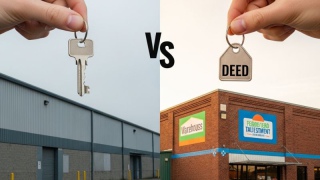The Illuminating Truth: How Warehouse Lighting Impacts Productivity and Safety

In the sprawling, often bustling ecosystem of a modern warehouse, every element plays a crucial role in the symphony of efficiency and safety. From the layout of the aisles to the technology employed for inventory management, each component contributes to the overall flow. Yet, one often-overlooked, yet profoundly impactful, element is the lighting. Far from being a mere utility, effective warehouse lighting is a strategic asset that directly influences productivity, worker well-being, and, critically, safety.
Beyond Just Seeing: The Multifaceted Impact of Light
The immediate association with lighting is, of course, visibility. Workers need to see what they're doing – identifying products, operating machinery, reading labels. However, the influence of lighting extends far beyond this basic requirement. It delves into the realms of human psychology, physiology, and operational efficiency.
The Productivity Equation: When Light Powers Performance
Imagine a worker squinting in dim light, struggling to read a barcode, or meticulously picking an item from a cluttered shelf under inadequate illumination. These seemingly minor frustrations accumulate, leading to significant drops in productivity. Here's how optimized warehouse lighting directly boosts output:
-
Enhanced Task Accuracy and Speed: When visibility is excellent, workers can perform tasks more quickly and with fewer errors. This translates to faster picking, packing, and shipping times, reducing bottlenecks and improving throughput. Clear visibility of product codes, labels, and even the general environment allows for swift and accurate decision-making.
-
Reduced Eyestrain and Fatigue: Poor lighting, characterized by glare, flicker, or insufficient illumination, forces the eyes to work harder, leading to eyestrain, headaches, and general fatigue. A tired worker is a less productive worker. Proper lighting minimizes these stressors, allowing employees to maintain focus and energy levels throughout their shifts. This is particularly crucial for tasks requiring sustained visual attention, such as quality control or intricate assembly.
-
Improved Concentration and Morale: Well-lit environments create a more pleasant and stimulating atmosphere. Conversely, dim, dreary spaces can contribute to feelings of lethargy and demotivation. Abundant, well-distributed light can positively impact mood and alertness, fostering greater concentration and a more positive work environment. This isn't just about avoiding gloom; it's about creating an active, vibrant space that encourages engagement.
-
Optimized Space Utilization: Adequate lighting ensures that all areas of the warehouse, including high shelving or less frequently accessed zones, are equally visible and usable. This prevents "dark spots" where inventory might be overlooked or tasks are performed less efficiently due to poor visibility. Every square foot of a warehouse is valuable, and proper lighting ensures that value is maximized.
-
Facilitating Automation and Technology Integration: Many modern warehouses rely on advanced technologies like automated guided vehicles (AGVs), robotics, and vision systems. These systems often require consistent and predictable lighting conditions to operate effectively. Inconsistent or poor lighting can interfere with sensors and cameras, leading to malfunctions or reduced performance of automated systems, thereby hindering overall operational efficiency.
Safety First: How Lighting Prevents Accidents
While productivity gains are highly desirable, safety in a warehouse is paramount. Warehouses, with their heavy machinery, high shelves, and constant movement, present inherent risks. Effective lighting is a fundamental safety measure, acting as a preventative shield against accidents and injuries.
-
Preventing Trips, Slips, and Falls: Uneven surfaces, spilled liquids, or misplaced objects become serious hazards in dimly lit areas. Proper lighting illuminates these potential dangers, allowing workers to identify and avoid them. Well-lit aisles and walkways are crucial for safe pedestrian and forklift traffic.
-
Enhancing Visibility of Hazards: Beyond general obstructions, lighting is critical for identifying specific hazards such as exposed wires, faulty equipment, or even the presence of pests. Clear visibility enables workers to react quickly and appropriately to mitigate risks.
-
Improving Machine Operation Safety: Operating forklifts, order pickers, or other heavy machinery requires acute spatial awareness and clear visibility of the surrounding environment, including other workers, obstacles, and the loading/unloading zones. Insufficient lighting can lead to misjudgments, collisions, and serious accidents. Well-lit workspaces contribute significantly to safer machine operation.
-
Reducing Human Error: Fatigue and poor visibility, often caused by inadequate lighting, are major contributors to human error. Mistakes in a warehouse can range from incorrect picking to dangerous operational blunders. Good lighting reduces the likelihood of such errors by keeping workers alert and ensuring they have a clear view of their tasks and surroundings.
-
Clearer Emergency Pathways: In the event of an emergency, such as a fire or power outage, well-designed emergency lighting is absolutely critical. This ensures that evacuation routes, exits, and safety equipment (like fire extinguishers) remain visible, guiding workers to safety even when primary power is lost.
-
Deterring Crime and Enhancing Security: While not directly related to internal operations, good external and internal warehouse lighting can deter theft and enhance overall security. Well-lit perimeters and loading docks make unauthorized access more difficult and visible, contributing to a safer environment for both personnel and assets.
The Right Light: Key Considerations for Warehouse Illumination
Achieving optimal warehouse lighting isn't a one-size-fits-all solution. Several factors must be considered to design an effective lighting system:
-
Illumination Levels (Lux): Different areas and tasks within a warehouse require varying levels of illumination. Picking areas, for example, might need higher lux levels than general storage areas. Industry standards and regulations (e.g., OSHA, EN 12464-1) provide guidelines for appropriate light levels.
-
Uniformity: Even distribution of light is crucial. Hot spots and dark patches create visual discomfort and compromise safety. Lighting design should aim for consistent illumination across the entire workspace.
-
Color Temperature (CCT): Measured in Kelvin, color temperature influences how colors appear and can impact alertness. Cooler temperatures (e.g., 5000K-6500K) are often preferred for task-oriented environments as they promote alertness, while warmer temperatures might be used in break areas.
-
Glare Control: Excessive glare, whether direct from the light source or reflected off surfaces, can be highly disruptive and dangerous. Proper fixture selection, shielding, and positioning are essential to minimize glare.
-
Flicker: Imperceptible flicker from some lighting technologies can cause eyestrain, headaches, and even trigger migraines. High-quality LED lighting with stable drivers minimizes flicker.
-
Energy Efficiency: While prioritizing productivity and safety, energy consumption is also a significant operational cost. Modern LED lighting solutions offer substantial energy savings compared to traditional fluorescent or HID lamps, with longer lifespans and reduced maintenance requirements.
-
Control Systems: Implementing smart lighting controls, such as motion sensors, daylight harvesting, and dimming capabilities, can further optimize energy usage and adapt lighting levels to real-time needs. For instance, lights in less-trafficked aisles can be dimmed until movement is detected.
-
Maintenance and Durability: Warehouse environments can be demanding. Lighting fixtures should be robust, dust-resistant, and easy to maintain, minimizing downtime and ensuring consistent performance.
The Evolution of Warehouse Lighting: Embracing LED Technology
The advent of LED (Light Emitting Diode) technology has revolutionized warehouse lighting. LEDs offer numerous advantages over traditional lighting sources:
-
Superior Energy Efficiency: LEDs consume significantly less energy, leading to substantial reductions in electricity bills and a lower carbon footprint.
-
Longer Lifespan: LEDs have significantly longer operational lifespans, reducing the frequency and cost of lamp replacements.
-
Instant On/Off: Unlike some traditional lights that require warm-up time, LEDs provide instant illumination, which is beneficial for motion-activated systems and in emergency situations.
-
Better Color Rendering Index (CRI): High CRI LEDs provide more accurate color perception, which is crucial for tasks requiring color differentiation.
-
Durability: LEDs are solid-state devices, making them more resistant to vibrations and impacts common in warehouse environments.
-
Dimming Capabilities: Most LED fixtures are easily dimmable, allowing for flexible lighting control.
Conclusion: An Investment, Not an Expense
In the competitive landscape of modern logistics, every operational advantage counts. Investing in optimal warehouse lighting is not merely an expenditure; it's a strategic investment with tangible returns. By directly impacting productivity through enhanced accuracy, speed, and morale, and by significantly improving safety through reduced accidents and clearer visibility of hazards, proper illumination becomes a cornerstone of efficient and responsible warehouse management. As warehouses continue to evolve with automation and sophisticated processes, the role of intelligent, high-quality lighting will only become more critical, truly illuminating the path to operational excellence.
_0x70_d59.png)



